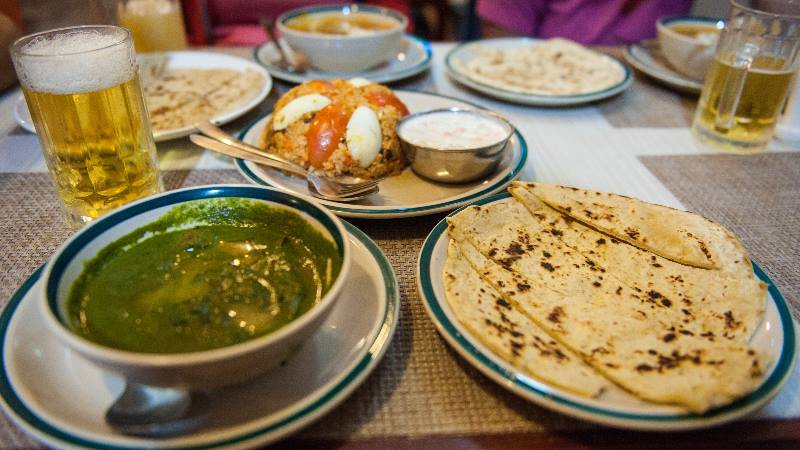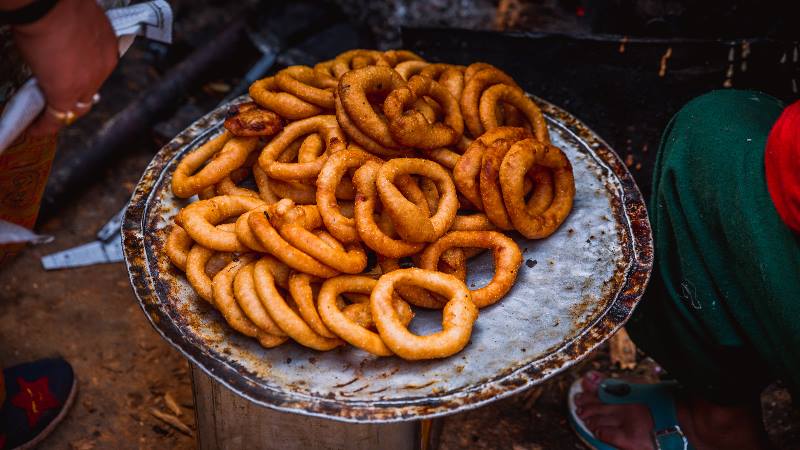The smell of chai masala steeping in hot milk fresh from the udder, melt-in-your-mouth Nepali chicken tenderly stewed in a complex algorithm of exotic spices and the sizzle of panipuri batter crisping into tamarind-infused bread pockets.
Food plays such a central role in Nepali life and from the crunch of a cumin seed or the pungency of ginger a microcosm of Nepali culture and tradition explodes. The first question on everybody’s lips is never “how are you” but rather “have you taken rice?” i.e. Have you eaten? Are you hungry? Let me feed you!!
Nepalese cuisine varies from region to region, and aama’s (mum’s) home cooking adapts with geography. For a taste of it all, nowhere compares to the capital: in Kathmandu, every regional diet and spice concoction comes together in one delicious and eclectic hotpot.
Customs and Culture

Before we dig in and indulge in foodie fantasy, it’s essential to learn a little something about Nepali customs and culture to avoid accidentally offending your host.
Never – and I mean NEVER – eat with your left hand. This hand is reserved for number one: washing and number two: well, number twos. It’s fine to hold a utensil or glass in that hand, but everything else is off-limits.
Sharing is not caring: if it has touched your lips, it’s now considered polluted. Lady and the tramp style spaghetti eating is entirely out of the question, and if someone offers you water, don’t let that bottle touch your lips.
Capiche?
Now, here’s what you should be sinking your teeth into in Kathmandu:
1. Dal Baht
Diet varies from region to region, but one staple remains the same throughout dal-baht. Eaten at breakfast, lunch or dinner…and often all three!
Lentil soup is poured onto boiled rice, mixed together, pinched into a saucy, sticky, sumptuous ball and popped into your mouth… all with one hand remember. Up for the challenge?
A traditional Tibetan trade-in for rice is called tsampa. A hearty, nutty-tasting dough made from mixing butter tea and barley flour. You’ll be transported back to childhood as you get handsy and creative eating the dough.
2. Thali Platter

If Dal Baht is to the Nepalis as meat and two veg is to the Brits, then a thali platter is the roast dinner. If for some inexplicable and inhumane reason you only eat out once in Kathmandu then ignore the rest of the menu and trust me on this.
The dishes vary from place to place, but essentially thali is a little bit of everything. A mound of rice encircled by a selection of dishes: maybe dal, a couple of achars (pickled vegetables), dahi (yoghurt), and a vegetable or Nepalese chicken curry. And don’t be afraid to ask for more of everything, it’s expected!
3. Spiced Cucumber
So incredibly basic but so weirdly moreish; for something a little more healthy this is one of my favourite snacks…and weirdly I’m generally not one for cucumber full stop – I find it bland, watery and boring. But in Nepal, cucumbers are much fleshier and fresher and grow bigger than watermelons. Sprinkled with a little salt, chilli, Sichuan pepper and turmeric. Simply yum!
4. Momos

These tasty Tibetan delicacies are similar to the Chinese dumpling: flour parcels pinched around a spiced meat or vegetable filling. Traditionally, momos were bundled with juicy buffalo meat, but on the streets of Kathmandu, you can find the snack stuffed with anything from vegetables to chicken, to cheese or even chocolate!
5. All the Rotis
As soup sings for a hunk of bread, a creamy curry calls for roti. Indian bread comes in a variety of guises, but my favourites are paratha and pani puri.
Paratha is a traditional flatbread that’s light, and flaky dough can be filled with any number of delicious concoctions of spices, vegetables and meats – kind of like chapatti, but better. Where parathas are flat, pani puris are fried until puffy, and the crispy shell is then filled with spicy potato.
6. Sel Roti

These sweet snacks warrant individual recognition because they are just so damn delicious. The traditional deep-fried, rice flour ‘skinny doughnuts’ are typically reserved for festivals and celebrations…but really serve as great snacks whenever the craving takes you. And it will. Often.
7. Jalebi & Barfi
Both of these typical Nepali snacks make for the perfect sweet treats – and I mean sugar-drenched, syrupy-sticky, coat the backs of your teeth SWEET! Calorie counters, read no further.
When it comes to jalebi, imagine a skinnier, chewier and much much sugary sel roti then shape it into a pretzel and coat it with saffron infused syrup. Heart-stoppingly scrumptious.
Barfi, on the other hand, is much more like a Nepali variant of fudge. Condensed milk and sugar mixed with anything you can dream up: almonds, coconut, rose-water, pistachio, fig, peanuts etc….
8. Kheer

This creamy and warming dessert will remind you of a Christmassy rice pudding. Spiced with cinnamon, cardamom & cloves and sprinkled with chopped nuts, this divine dish is said to be a favourite with Lord Krishna. What better recommendation than that?
9. Cumin Cookies
As a sweet-toothed, tea-drinking & biscuit-tin guarding Brit, I’ve dunked my fair share of digestives and nibbled my way through a hobnob or two. But these buttery, sweet and subtly spiced rice-flour biccies trump them all.
In fact, the only thing better than a cumin biscuit is a cumin biscuit with a cup of tea…
10. Chiya

Nepal is famous for its tea and produces approximately 16.29 million kilograms of the stuff a year. Nepali tea – or chiya – varies in meaning from home to home. In Tibetan areas, their cuppa is butter tea (made from churning yak butter with tea and salt) while in rural Illam it is closer to what we know as black tea. The best, however, is chai masala. This milk tea is fragrantly spiced with cardamom, cloves and cinnamon and generally drank sugary sweet. Chink chink.
Street food in Kathmandu will forever set my tummy rumbling…where have your taste buds taken you?